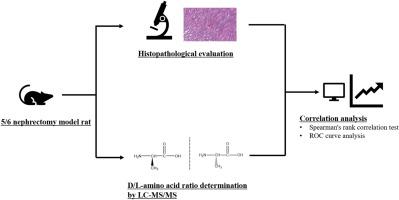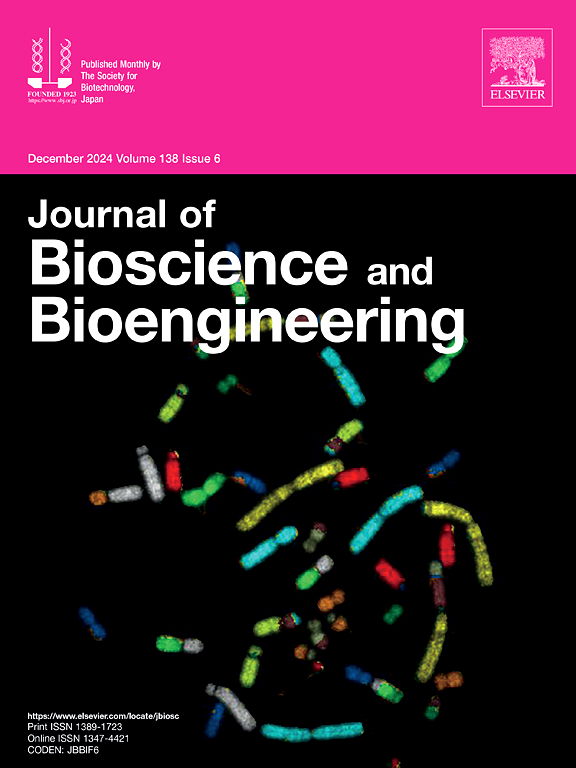5/6肾切除模型大鼠尿D/ l -氨基酸比值与肾损伤的相关性分析。
IF 2.9
4区 生物学
Q3 BIOTECHNOLOGY & APPLIED MICROBIOLOGY
引用次数: 0
摘要
肾脏损伤,如慢性肾脏疾病(CKD),是一个全球性的公共卫生问题。最近的研究报道了几种D/ l -氨基酸比率在肾损伤期间受到影响;然而,大多数报道都集中在肾功能障碍上,很少有报道关注D/ l -氨基酸变化与肾脏组织病理学改变之间的关系。因此,我们旨在探讨D/ l -氨基酸比例与5/6肾切除术大鼠模型肾损伤的组织病理学结果的相关性。在这项研究中,D/ l -氨基酸比率通过术后1、2、3和4周收集的尿液样本进行评估。D/L-Ser和D/L-Ala比值分别提高了3.0倍和9.3倍,其他D/ l -氨基酸比值,如D/L-Arg、D/L-Asn、D/L-His、D/L-Ile、D/L-Lys、D/L-Phe和D/L-Thr比值也比假手术组高。与假手术组相比,在整个评估期间尿中D/ l -氨基酸比率始终保持不变。但仅D/L-Gln比假手术组低。D/ l -氨基酸比值与肾组织病理学改变的相关性分析显示,术后1周D/L-Ala、D/L-Glu、D/L-Gln与肾小管扩张有良好的相关性。没有其他研究结果显示与上述氨基酸的D/ l -氨基酸比率的变化有很强的相关性。通过评估尿D/ l -氨基酸比率,我们可以无创地检测肾小管扩张,并了解肾脏的生理状况。本文章由计算机程序翻译,如有差异,请以英文原文为准。

Correlation analysis of urinary D/L-amino acid ratios and renal injury by using 5/6 nephrectomy model rats
Renal injury, such as chronic kidney disease (CKD), is a global public health problem. Recent studies have reported that several D/L-amino acid ratios are affected during renal injury; however, most reports have focused on renal dysfunction, and few have focused on the association between D/L-amino acid changes and histopathological alterations in the kidney. Therefore, we aimed to investigate the correlation between D/L-amino acid ratios and the histopathological findings of renal injury in a 5/6 nephrectomy rat model. In this study, the D/L-amino acid ratios were evaluated using urine samples collected 1, 2, 3, and 4 weeks after surgery. The D/L-Ser and D/L-Ala ratios were 3.0-fold and 9.3-fold higher, respectively, and the other D/L-amino acid ratios, such as D/L-Arg, D/L-Asn, D/L-His, D/L-Ile, D/L-Lys, D/L-Phe, and D/L-Thr ratios, also showed higher values than those in the sham group. The D/L-amino acid ratios in the urine were consistently maintained throughout the evaluation period compared to those in the sham group. However, only the D/L-Gln ratio was lower than that in the sham group. Correlation analysis between D/L-amino acid ratios and histopathological alterations in the kidney revealed a good correlation between D/L-Ala, D/L-Glu, and D/L-Gln one week after surgery and tubular dilatation. No other findings showed a strong correlation with the changes in the D/L-amino acid ratios of the aforementioned amino acids. By evaluating urinary D/L-amino acid ratios, we could potentially detect tubular dilatation in the kidney noninvasively and obtain insights into the physiological condition of the kidney.
求助全文
通过发布文献求助,成功后即可免费获取论文全文。
去求助
来源期刊

Journal of bioscience and bioengineering
生物-生物工程与应用微生物
CiteScore
5.90
自引率
3.60%
发文量
144
审稿时长
51 days
期刊介绍:
The Journal of Bioscience and Bioengineering is a research journal publishing original full-length research papers, reviews, and Letters to the Editor. The Journal is devoted to the advancement and dissemination of knowledge concerning fermentation technology, biochemical engineering, food technology and microbiology.
 求助内容:
求助内容: 应助结果提醒方式:
应助结果提醒方式:


